fuel cap CADILLAC SEVILLE 1996 4.G Owners Manual
[x] Cancel search | Manufacturer: CADILLAC, Model Year: 1996, Model line: SEVILLE, Model: CADILLAC SEVILLE 1996 4.GPages: 354, PDF Size: 20.21 MB
Page 132 of 354
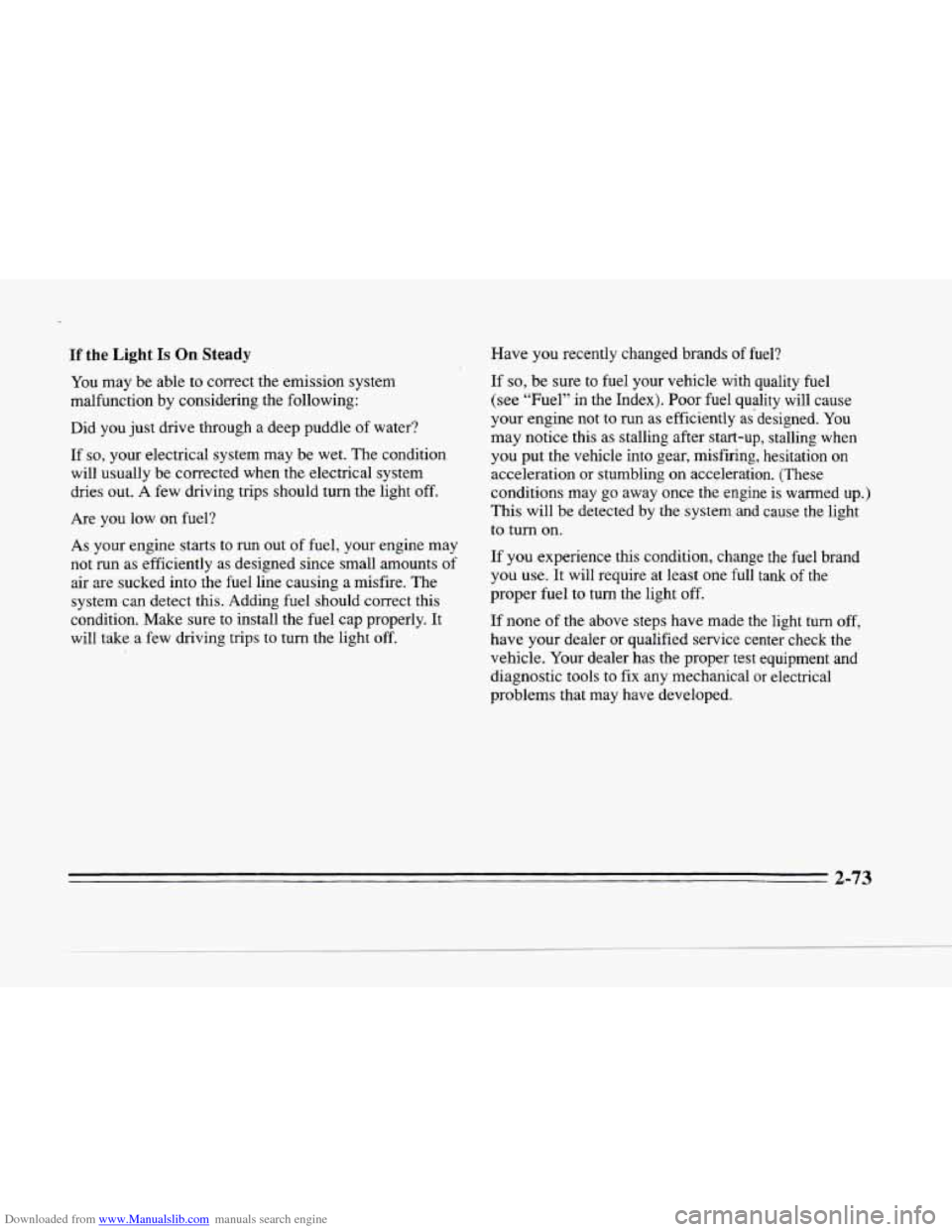
Downloaded from www.Manualslib.com manuals search engine L
If the Light Is On Steady
You may be able to correct the emission system
malfunction by considering the following:
Did you just drive through a deep puddle of water?
If
so, your electrical system may be wet. The condition
will usually be corrected when the electrical system
dries out.
A few driving trips should turn the light off.
Are you low on fuel?
As your engine starts to run out of fuel, your engine may
not run as efficiently as designed since small amounts
of
air are sucked into the fuel line causing a misfire. The
system can detect this. Adding fuel should correct this
condition. Make sure to install the fuel cap properly. It
will take a few driving trips to turn the light
off.
Have you recently changed brands of fuel?
If
so, be sure to fuel your vehicle with quality fuel
(see “Fuel”
in the Index). Poor fuel quality will cause
your engine not to run as efficiently asdesigned.
You
may notice this as stalling after start-up, stalling when
you put the vehicle into gear, misfiring, hesitation on
acceleration or stumbling on acceleration. (These
conditions may go away once the engine is warned
up.)
This will be detected by the system and cause the light
to turn on.
If you experience this condition, change the fuel brand
you use.
It will require at least one full tank of the
proper fuel to turn the light off.
If none of the above steps have made the light turn
off,
have your dealer or qualified service center check the
vehicle. Your dealer has the proper test equipment and
diagnostic tools to fix any mechanical
or electrical
problems that may have developed.
Page 134 of 354
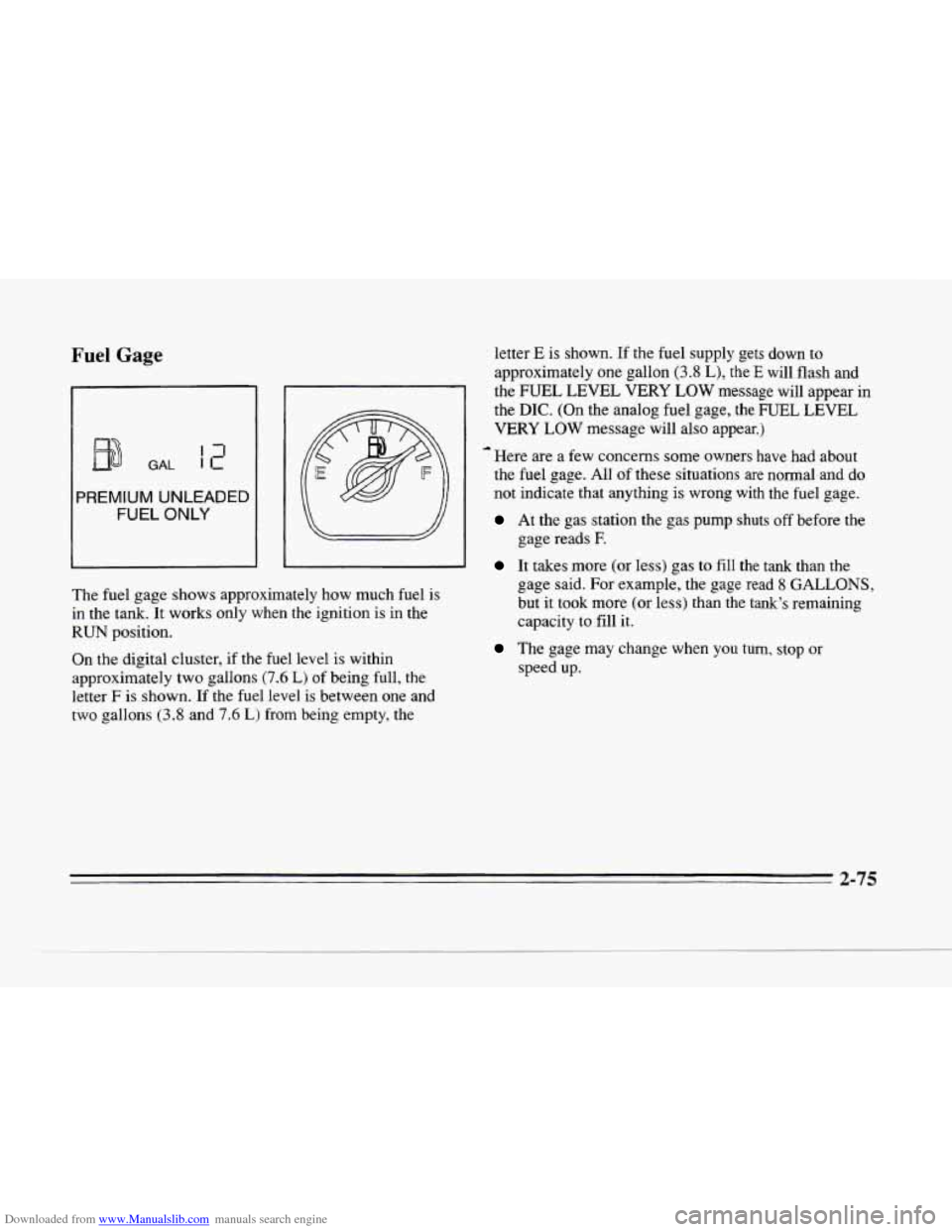
Downloaded from www.Manualslib.com manuals search engine c
Fuel Gage
GAL
PREMIUM UNLEADED
FUEL ONLY
The fuel gage shows approximately how much fuel is
in the tank. It works only when the ignition is in the
RUN position.
On the digital cluster, if the fuel level is within
approximately two gallons
(7.6 L) of being full, the
letter
F is shown. If the fuel level is between one and
two gallons
(3.8 and 7.6 L) from being empty, the letter
E is
shown. If the fuel supply gets down to
approximately one gallon
(3.8 L), the E will flash and
the FUEL LEVEL VERY
LOW message will appear in
the
DIC. (On the analog fuel gage, the FUEL LEVEL
VERY
LOW message will also appear.)
Here are a few concerns some owners
have had about
the fuel gage. All of these situations are normal and do
not indicate that anything is wrong with the fuel
gage.
At the gas station the gas pump shuts off before the
It takes more (or less) gas to filI the tank than the
1
gage reads F.
gage said. For example, the gage read 8 GALLONS,
but it took more (or less) than the tank’s remaining
capacity to fill it.
The gage may change when you turn, stop or
speed up.
2-75
Page 212 of 354
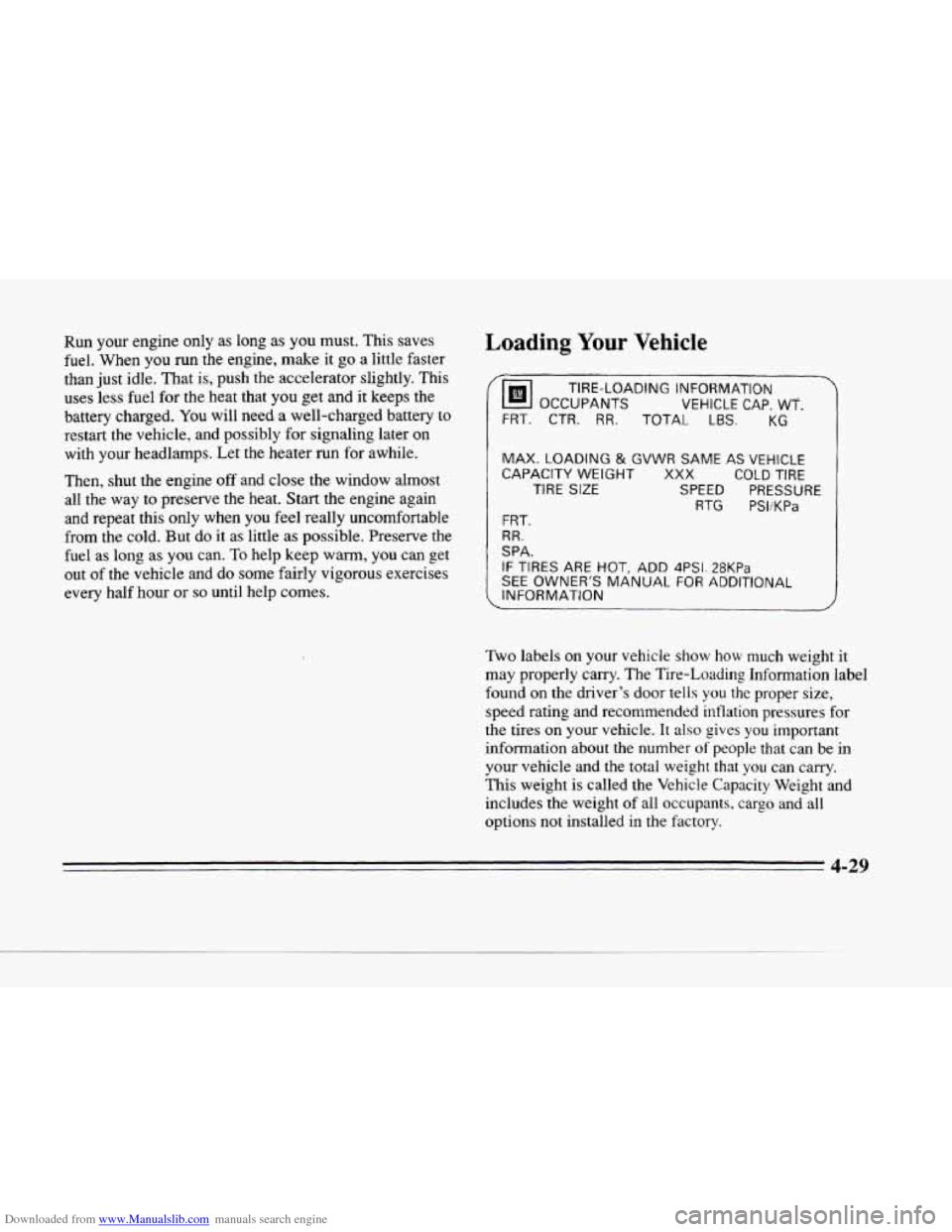
Downloaded from www.Manualslib.com manuals search engine c
P
. ‘.
L
-.
Run your engine only as long as you must. This saves
fuel. When you
run the engine, make it go a little faster
than just idle. That
is, push the accelerator slightly. This
uses less fuel for the heat that you get and it keeps the
battery charged.
You wili need a well-charged battery to
restart the vehicle, and possibly for signaling later on
with your headlamps. Let the heater
run for awhile.
Then, shut the engine off and close the window almost
all the way to preserve the heat. Start the engine again
and repeat this only when you feel really uncomfortable
from the cold. But do it as little
as possible. Preserve the
fuel as long as you can.
To help keep warm, you can get
out of the vehicle and do some fairly vigorous exercises
every half hour
or so until help comes.
Loading Your Vehicle
(m OCCUPANTS VEHICLE CAP. WT.
TIRE-LOADING INFORMATION
FRT. CTR. RR. TOTAL LBS. KG
MAX. LOADING & GVWR SAME AS VEHICLE
CAPACITY WEIGHT XXX COLD TIRE
TIRE SIZE SPEED PRESSURE
RTG PSliKPa
FRT.
RR.
SPA.
IF TIRES ARE HOT, ADD 4PSI. 28KPa
SEE OWNER’S MANUAL FOR ADDITIONAL
INFORMATION
Two labels on your vehicle show how much weight it
may properly carry. The Tire-Loading Information label
found on the driver’s
door tells you the proper size,
speed rating and recommended inflation pressures for
the tires on your vehicle. It also gives you important
information about the number
of people that can be in
your vehicle and the total weight that you can carry.
This weight
is called the Vehicle Capacity Weight and
includes the weight
of all occupants, cargo and all
options not installed in the factory.
d
Page 213 of 354
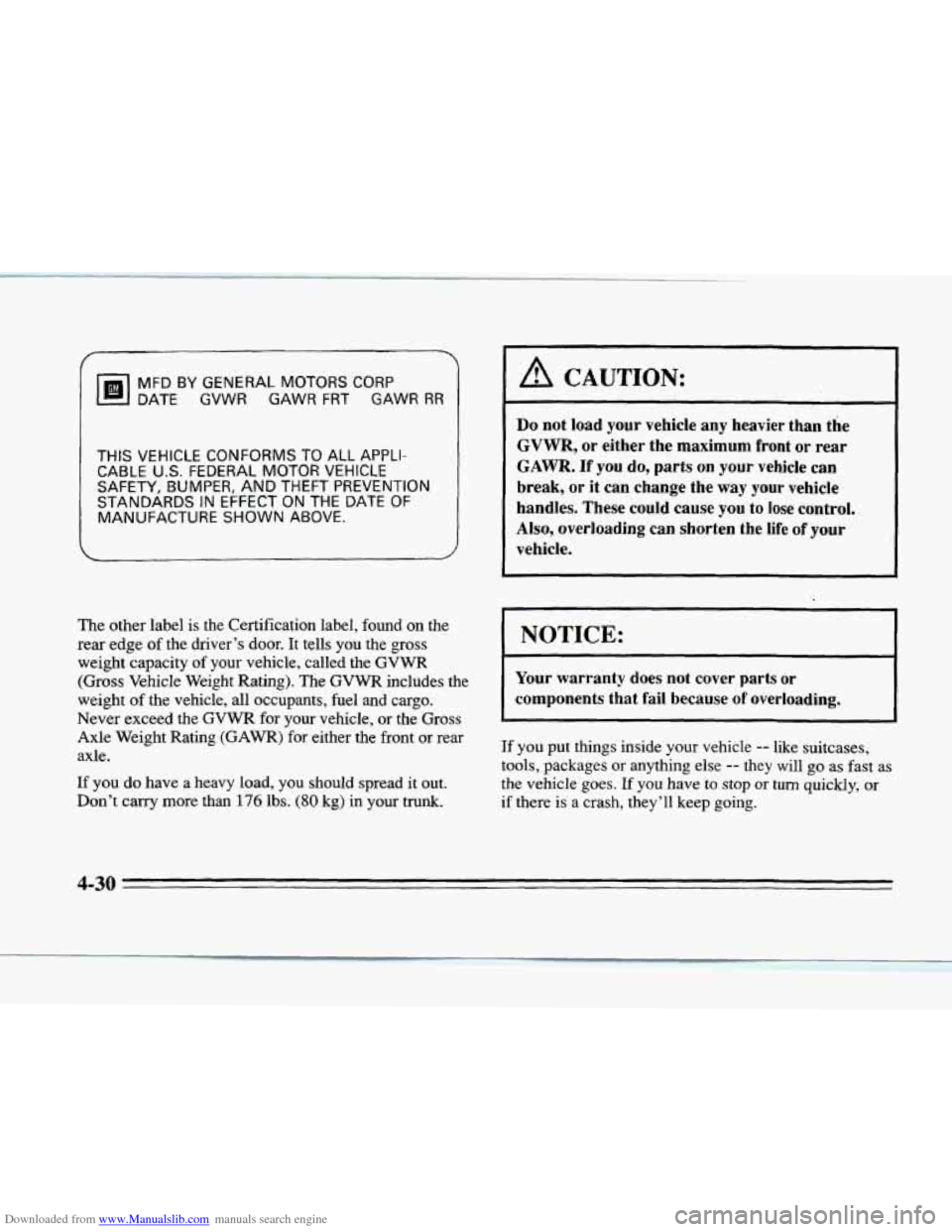
Downloaded from www.Manualslib.com manuals search engine I
MFD BY GENERAL MOTORS CORP
DATE GVWR GAWR FRT GAWR RR
THJS VEHICLE CONFORMS TO ALL APPLI
CABLE U.S. FEDERAL 'MOTOR VEHiCLE
SAFETY, BUMPER,
AND THEFT PREVENT
STANDARDS
IN EFFECT ON THE DATE 0
MANUFACTURE SHOWN ABOVE.
'ION
IF
The other label is the Certification label, found on the
rear edge
of the driver's door. It tells you the gross
weight capacity of your vehicle, called the GVWR
(Gross Vehicle Weight Rating). The GVWR includes the
weight of the vehicle,
all occupants, fuel and cargo.
Never exceed the
GVWR for your vehicle, or the Gross
Axle Weight Rating
(GAWR) for either the front or rear
axle.
If you do have a heavy load, you should spread it out.
Don't carry more than
176 lbs. (80 kg) in your trunk.
A CAUTION:
Do not load your vehicle any heavier than the
GVWR, or either the maximum front or rear
GAWR. If you do, parts on your vehicle can
break, or
it can change the way your vehicle
handles. These could cause
you to lose control.
Also, overloading can shorten the life
of your I-'
vehicle.
~ ._._,__ -. .~ -_?p_ -. _ . . . . I_ ~~.
NOTICE:
Your warranty does not cover parts or
components that fail because of overloading.
If you put things inside your vehicle -- like suitcases,
tools, packages or anything else
-- they will go as fast as
the vehicle goes.
If you have to stop or turn quickly, or
if there is a crash, they'll keep going.
L
1
b
4-30
Page 215 of 354
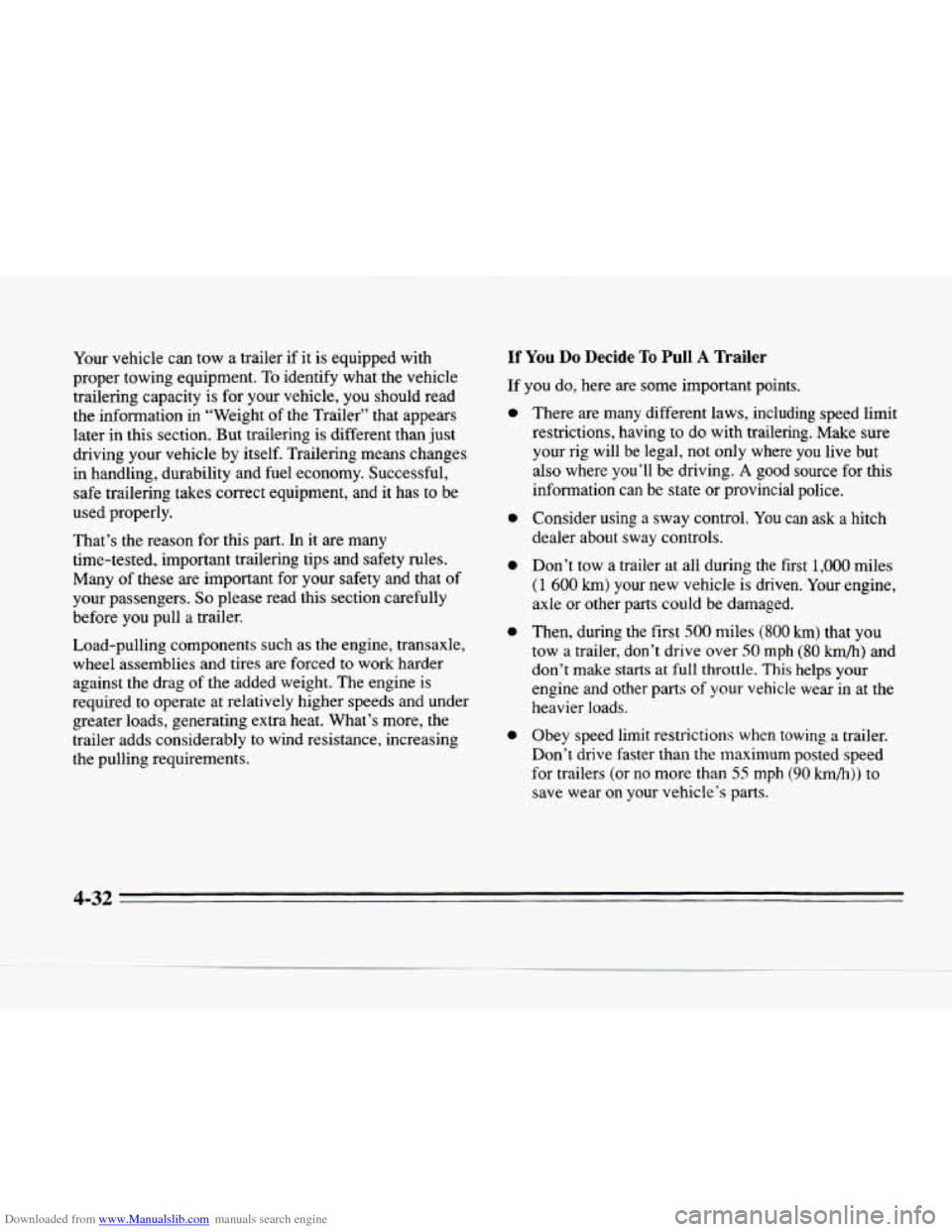
Downloaded from www.Manualslib.com manuals search engine Your vehicle can tow a trailer if it is equipped with
proper towing equipment. To identify what the vehicle
trailering capacity is for your vehicle,
you should read
the infomation in “Weight of the Trailer” that appears
later in this section. But trailering
is different than just
driving your vehicle by itself. Trailering means changes
in handling, durability and fuel economy. Successful,
safe trailering takes correct equipment, and it has to be
used properly.
That’s the reason for this part. In it
are many
time-tested, important trailering tips and safety rules.
Many of these
are important for your safety and that of
your passengers. So please read this section carefully
before you pull a trailer.
Load-pulling components such as the engine, transaxle,
wheel assemblies and tires
are forced to work harder
against the drag of the added weight. The engine is
required to operate at relatively higher speeds and under
greater loads, generating extra heat. What’s more, the
trailer adds considerably to wind resistance, increasing
the pulling requirements.
If You Do Decide To Pull A Trailer
If you do, here are some important points.
0
0
0
0
0
There are many different laws, including speed limit
restrictions, having to do with trailering. Make sure
your rig will be legal, not only where
you live but
also where you’ll
be driving. A good source for this
information can be state or provincial police.
Consider using a sway control. You can ask a hitch
dealer about sway controls.
Don’t tow a trailer at all during the first
1,000 miles
(1 600 km) your new vehicle is driven. Your engine,
axle or other parts could be damaged.
Then, during the first
500 miles (800 km) that you
tow a trailer, don’t drive over
SO mph (80 km/h) and
don’t make starts at
full throttle. This helps your
engine and other
parts of your vehicle wear in at the
heavier loads.
Obey speed limit restrictions when towing a trailer.
Don’t drive faster than the maximum posted speed
for trailers (or
no more than 55 mph (90 km/h)) to
save wear
on your vehicle’s parts.
c
4-32
Page 263 of 354

Downloaded from www.Manualslib.com manuals search engine Filling Your Tank
The cap is behind a hinged door on the driver's side of
your vehicle.
A CAUTION:
Gasoline vapor is highly flammable. It burns
violently, and that can cause very bad injuries.
Don't smoke
if you're near gasoline or refueling
your vehicle.
Keep sparks, flames and smoking
materials away from gasoline.
.. .
The fuel door release is
located
on the optional full
console and on the Keyless
Entry transmitter. If .your
vehicle
is not equipped with
the full console, then
you
must use the transmitter to
open the fuel door.
I An alternate fuel door
~ release is located inside of
~ the trunk on the left hand
side. Pull it to release the
fuel
door.
6-4
Page 264 of 354
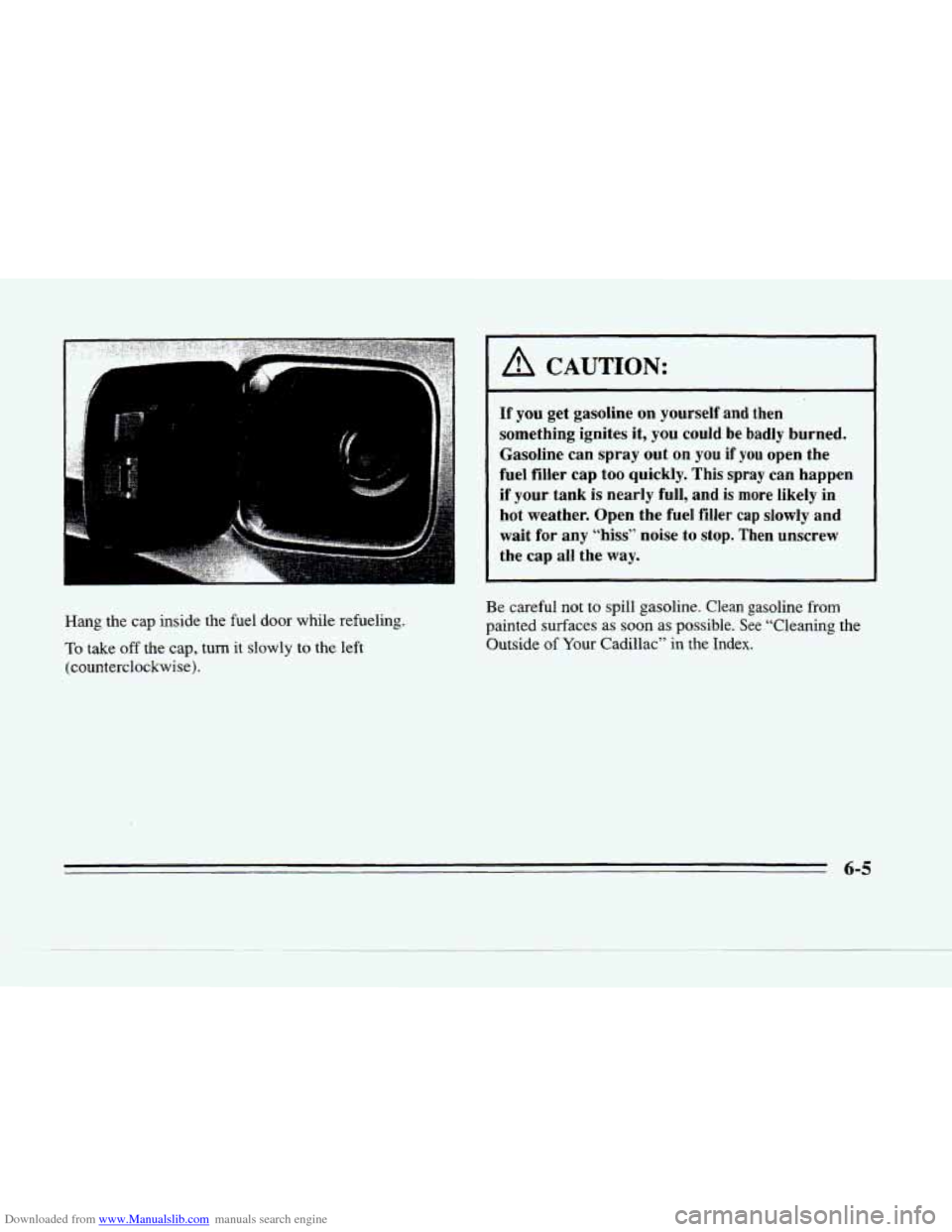
Downloaded from www.Manualslib.com manuals search engine e
Hang the cap inside the fuel door while refueling.
To take off the cap, turn it slowly to the left
(counterclockwise).
I A CAUTION:
If you get gasoline on yourself and then
something ignites it, you could be badly burned.
Gasoline can spray out on
you if you open the
fuel filler cap too quickly. This
spray can happen
if your tank is nearly full, and
is more likely in
hot weather. Open the fuel
filler cap slowly and
wait
for any “hiss” noise to stop. Then unscrew
the cap
all the way.
Be careful not
to spill gasoline. Clean gasoline from
painted surfaces as soon as possible. See “Cleaning the
Outside
of Your Cadillac” in the Index.
6-5
Page 265 of 354

Downloaded from www.Manualslib.com manuals search engine When you put the cap back on, turn it to the right until
you hear at least three clicks. Make sure you fully install
the
cap.
I NOTICE:
If you need a new cap, be sure to get the right
type. Your dealer can get one for you. If you get
the wrong type, it may not fit
or have proper
venting, and your fuel tank and emissions system
might be damaged.
Checking Things Under the Hood
A CAUTION:
..
An electric fan under the hood can start up and
injure you even when the engine
is not running.
Keep hands, clothing and tools away from any
underhood electric fan.
A CAUTION:
Things that burn can get on hot engine parts and
start
a fire. These include liquids like gasoline,
oil, coolant, brake fluid, windshield washer and
other fluids,
and plastic or rubber. You or others
could be burned.
Be careful not to drop or spill
things that will
burn onto a hot engine.
6-6
Page 296 of 354
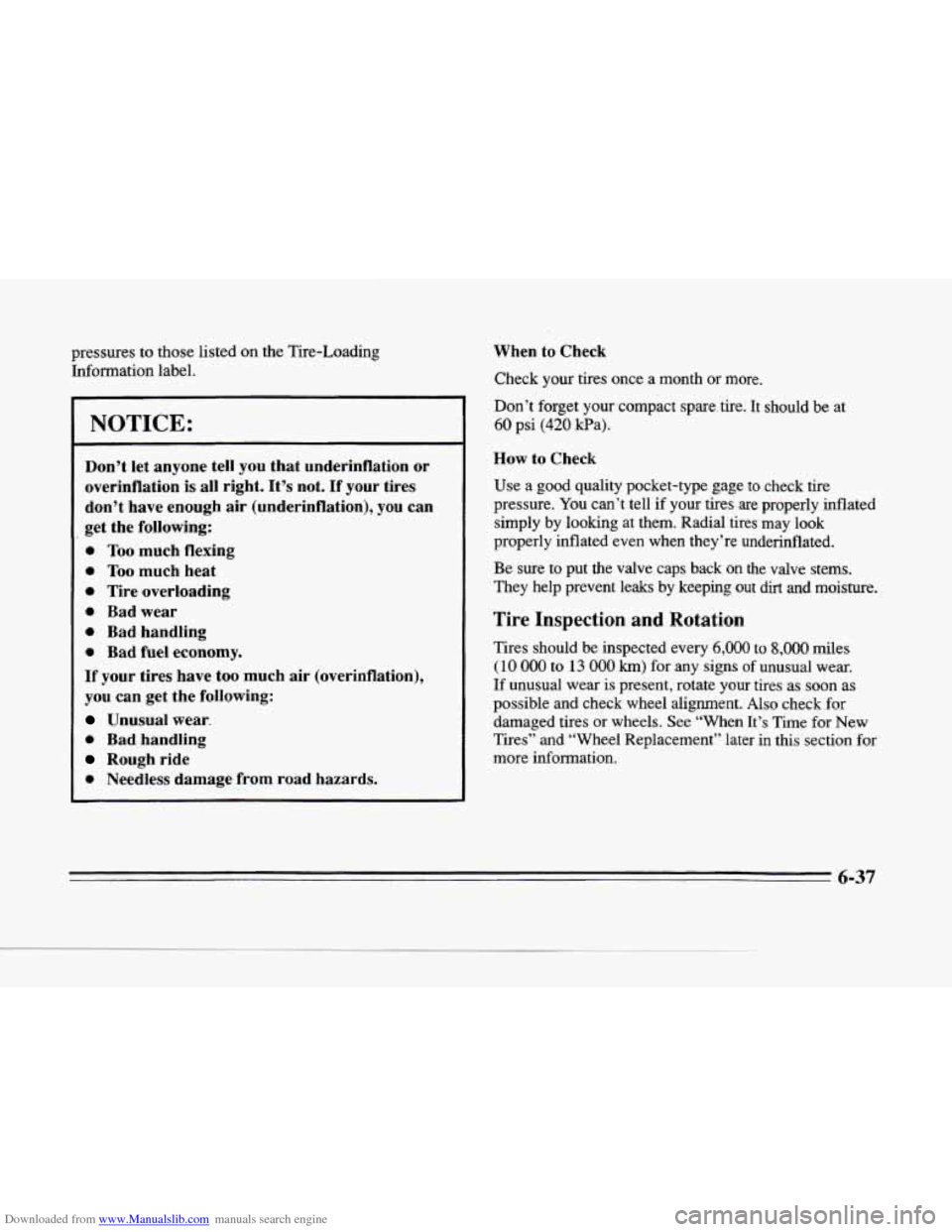
Downloaded from www.Manualslib.com manuals search engine c
rc
pressures to those listed on the Tire-Loading
Information label.
NOTICE:
Don’t let anyone tell you that underinflation or
overinflation
is all right. It’s not. If your tires
don’t have enough
air (underinflation), you can
get the following:
0 Too much flexing
0 Too much heat
0 Tire overloading
0 Bad wear
0 Bad handling
0 Bad fuel economy.
If your tires have too much air (overinflation),
you can get the following:
Unusual wear.
0 Bad handling
Rough ride
0 Needless damage from road hazards. When to
Check
Check
your tires once a month or more.
Don’t forget your compact spare.
tire. It should be at
60 psi (420 kPa).
How
to Check
Use a mod quality pocket-type gage to check tire
pressure. You can’t tell if your tires are properly inflated
simply by looking at them. Radial tires may look
properly inflated even when they’re underinflated.
Be sure to put the valve caps back
on the valve stems.
They help prevent leaks by keeping out dirt
and moisture.
Tire Inspection and Rotation
Tires should be inspected every 6,000 to 8,000 miles
( 10 000 to 13 000 km) for any signs of unusual wear.
If unusual wear is present, rotate your tires as soon as
possible and check wheel alignment. Also check for
damaged tires or wheels. See
“When It’s Time for New
Tires” and “Wheel Replacement” later
in this section for
more information.
6-37
Page 323 of 354
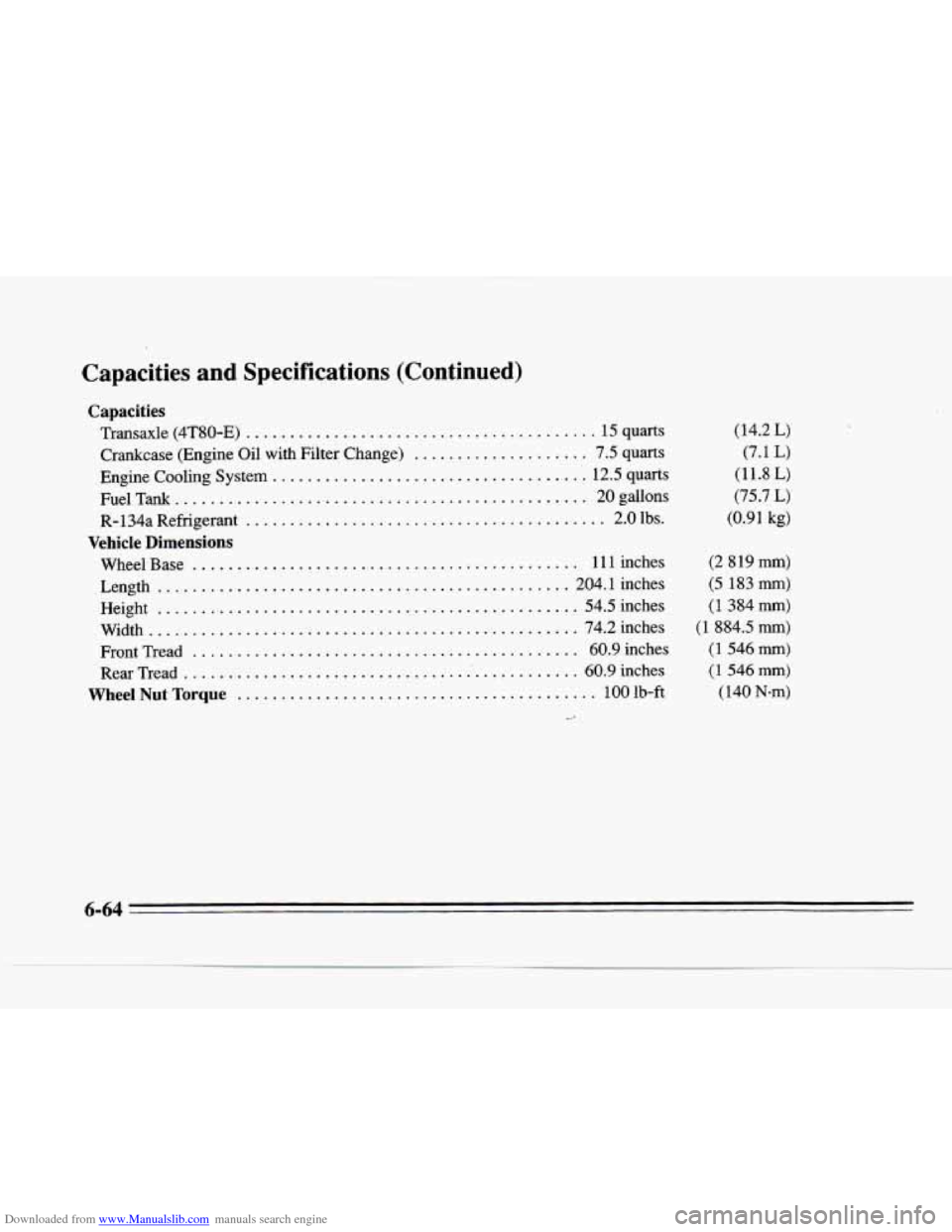
Downloaded from www.Manualslib.com manuals search engine Capacities and Specifications (Continued)
Capacities
Transaxle (4T80-E) ........................................ 15 quarts
Crankcase (Engine Oil with Filter Change)
.................... 7.5 quarts
Engine Cooling System
.................................... 12.5 quarts
R-134a Refrigerant ......................................... 2.0 lbs.
Wheel Base
............................................ 11 1 inches
Length
............................................... 204.1inches
Height
................................................ 54.5 inches
Width
................................................. 74.2 inches
Front Tread
............................................ 60.9 inches
Wheel Nut Torque .......................................... 100 lb-ft
FuelTank
............................................... 20gallons
Vehicle Dimensions
Rear Tread .............................................. 60.9 inches
-.
(14.2 L)
(7.1 L)
(11.8
L)
(75.7 L)
(0.91 kg)
(2 819 mm)
(5 183 mm)
(1 384 mm)
(1 884.5 mm)
(1 546 mm)
(1 546 mm)
( 140 N-m)
6-64